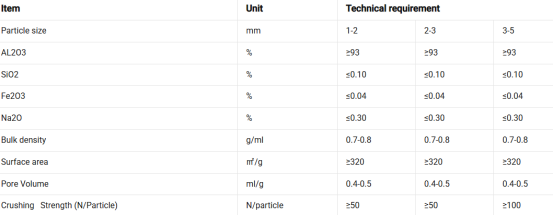The day before yesterday, we helped the customer select an activated alumina defluoridating agent and recommended 2-3mm activated alumina based on its operating environment and actual application data.

Some data of Zibo Xiangrun activated alumina defluoridant
So, besides specific surface area, pore volume, bulk density, and strength, what other important characteristics are there? They are listed below.
Strict control of chemical composition directly impacts fluoride removal effectiveness and effluent safety:
1. The core role of an Al2O3 content ≥93% is:
Ensuring sufficient active adsorption sites and guaranteed fluoride removal capacity
Providing a stable crystal structure to withstand frequent regeneration cycles
2. The significance of a Na2O content ≤0.30% is:
Ensuring drinking water safety: Strictly controlling sodium ion dissolution to prevent secondary water contamination
Improving thermal stability: Reducing the risk of structural sintering during high-temperature regeneration
Maintaining chemical stability: Maintaining stable performance under alkaline conditions
3. Precise control of impurity content:
SiO2 ≤0.10%: Preventing pore blockage and affecting mass transfer efficiency
Fe2O3 ≤0.04%: Preventing heavy metal dissolution and ensuring effluent safety
Consistent chemical composition ensures consistent quality between batches
What factors affect operation?
pH: Optimal operating range: 5.5-6.5
Temperature: 10-30°C
Competing ions: Sulfate, carbonate, etc.
Contact time: EBCT ≥ 5 minutes
Particle size recommendations:
1-2mm: Suitable for applications with high fluoride concentrations and requiring rapid adsorption
2-3mm: Optimal overall performance, suitable for most municipal water supply projects
3-5mm: Low operating pressure drop, suitable for high-flow treatment systems
Summary of the technical advantages of Zibo Xiangrun's activated alumina defluoridation agent:
1. Highly efficient defluoridation: Under optimal conditions, the defluoridation rate can reach over 98%.
2. Safe and reliable: Strict chemical composition control ensures safe effluent.
3. Economical and practical: Long service life and low operating costs.
4. Excellent regeneration: Multiple regeneration is possible, resulting in significant overall cost advantages.
5. Strong adaptability: Suitable for water treatment systems of varying sizes.













